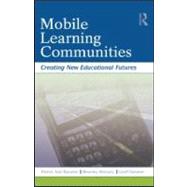
Note: Supplemental materials are not guaranteed with Rental or Used book purchases.
Purchase Benefits
Looking to rent a book? Rent Mobile Learning Communities: Creating New Educational Futures [ISBN: 9780415991582] for the semester, quarter, and short term or search our site for other textbooks by Danaher; Patrick Alan. Renting a textbook can save you up to 90% from the cost of buying.
| Introduction | |
| Networks and Partnerships | |
| To be effective and sustainable, mobile communities must develop and extend mutually respectful and beneficial networks and partnerships within and outside those communities | |
| This chapter identifies a diversity of strategies by which mobile community members assess and engage in potential opportunities for establishing such networks and partnerships | |
| The chapter also interrogates the crucial impact of those internal and external relationships on community members' access to efficient and equitable pathways into formal, non-formal and informal learning | |
| Lifelong Learning: From the Cradle to the Grave | |
| What does lifelong learning mean in the context of the lives of mobile community members who move on a regular basis and take with them all or most of the artifacts that are needed for day-to-day living, learning and earning? | |
| This chapter addresses this question by examining the roles that are played by personnel who travel as part of these communities, how those roles are learned and how they are taught | |
| It also looks at learning that is not specifically connected with traditional roles in a strict sense but which is necessary in order to respond to changing circumstances, attitudes and interests outside the community | |
| Technologies and Their Users | |
| Technologies have not only had their place in the mobile communities of bargees, circus and agricultural show people throughout the history of the existence of those communities but they are also integral and imperative to their operations | |
| From the high wire to the ferris wheel, the dodgem cars to the barges there would be little remaining in these communities if technologies were removed | |
| Equally important are the ways that personnel and clients interact with and through those technologies | |
| This chapter explores these themes in a way that also shows connections with lifelong learning and how members of these communities seek to guarantee their continued relevance to the outside community and the ongoing existence of their operations | |
| Globalisation and Interactions with the Outside World | |
| The chapter on globalisation and interactions with the outside world picks up and extends on the point reached in the chapter on technologies | |
| One of the underlying tensions in much of the discussion in this chapter is the idea that mobile communities that can appear inward looking and almost self-sustaining also need to be aware of and respond to particular challenges presented by the outside world | |
| It is more than the imperative to remain viable, however, that can lead those communities to adopt a more globalised perspective and to promote interactions with the outside world that are beyond what they regularly do | |
| This chapter, through its exploration of the ways that these communities respond to and interact in a globalised world, broadens readers' understandings and interpretations of bargee, circus and show communities | |
| The Knowledge Economy and Workplace Learning | |
| Increasingly work is understood as a mobile activity, displaced from some fixed location within a factory or shop and mobilised across a range of sites such as the home, online and overseas | |
| The forms of learning that take place within these mobile workplaces are similarly complex and shifting | |
| Creating viable workplace | |
| Table of Contents provided by Publisher. All Rights Reserved. |
The New copy of this book will include any supplemental materials advertised. Please check the title of the book to determine if it should include any access cards, study guides, lab manuals, CDs, etc.
The Used, Rental and eBook copies of this book are not guaranteed to include any supplemental materials. Typically, only the book itself is included. This is true even if the title states it includes any access cards, study guides, lab manuals, CDs, etc.